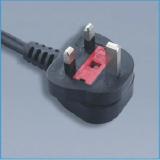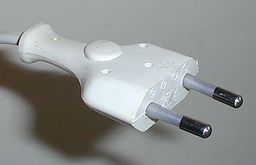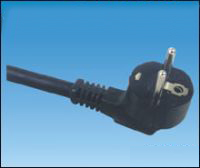Power Cords
A power cord, line cord, or mains cable is a cord or cable that temporarily connects an electrical appliance to the distribution circuits of an electrical power source via a wall socket or extension cord. The connector at both ends of the cable needs to be specified correctly to make the right connection
Plugs for wall socket connections |
(For the many different styles worldwide see Electrical Plugs and sockets - Worldwide) |
|
UK Power Cord BS1363 UK Power Cord - Fused and earthed (IEC Class l) | |
| Europlug Power Cord CEE 7/16
| |
|
Schuko Plug CEE 7/4
"Schuko" is the colloquial name for a system of AC power plugs and sockets that is defined as "CEE 7/4" or known unofficially as "Type F". Two pin plus earth with current up to 16 Amps (IEC Class l) | |
Plugs for equipment connections |
|

|
Figure 8 - IEC C7 The C7 and C8 connectors, with two pins rated at 2.5 A, exist in both polarised and unpolarised versions. The unpolarised C7 is commonly known as a "Figure 8" or "shotgun" connector due to its shape. (IEC Class ll) |
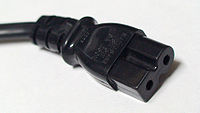
|
Figure 8 Polarised - IEC C8
The figure 8 polarised C8 is asymmetrical, with one end rounded similarly to the unpolarised version, and the other square. These connectors are often used for small cassette recorders, battery/mains operated radios, some full size AV equipment (projectors active speakersetc), laptop computer power supplies, video game consoles, and similar double-insulated (IEC Class ll) appliances. Unpolarised C7 connectors can be inserted into polarized C8 sockets; however, doing so might be a safety risk if the device is designed to expect a polarised power connection. |
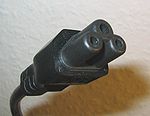
|
Clover Leaf - IEC - C5
The C5 3-conductor 2.5 A is sometimes colloquially called "Mickey Mouse" (because the cross section looks like the silhouette of the Disney character) or "Cloverleaf". (IEC Class ll) |

|
IEC C13 or PC Power Cord - IEC C13
When used with no other qualifiers, "IEC connector" usually refers specifically to the IEC C13 and C14 connectors (C14 is the female version of the C13). 3-conductor 10 A. Most desktop personal computers use the ten-amp panel-mounting C14 inlet to attach the power cord to the power supply, as do many monitors, printers and other peripherals. (IEC Class l) |

|
IEC C14 (Panel mount)
Many AT form factor computers also provided a panel-mounting C13 outlet controlled by the physical power switch for powering the monitor. With the arrival of ATX the readily accessible permanent power switch was removed and the outlet was either permanently powered or completely removed. A three-conductor cord with a suitable power plug for the locality in which the appliance is used on one end and a C13 line socket on the other is commonly called an "IEC cord." IEC cords are used to power many pieces of electronic equipment other than computers, for example instrument amplifiers and professional audio equipment. |
